The Multiple Stages of Regional Triassic Crustal Reworking in Eastern Tianshan, NW China: Evidence from the Xigebi Area
Abstract
1. Introduction
2. Geological Setting and Petrography
2.1. Geological Setting
2.2. Petrography
3. Methods
3.1. LA-ICP-MS Zircon Analyses
3.2. Zircon U-Pb Ages
3.3. Lu-Hf Isotopes
3.4. Whole-Rock Geochemistry
4. Results
4.1. Zircon U-Pb Ages
4.2. Whole-Rock Geochemistry
4.2.1. Hbl-Rich Diorite
4.2.2. Monzogranite
4.2.3. Zircon Lu-Hf Isotopes
5. Discussion
5.1. Petrogenesis
5.1.1. Hbl-Rich Diorite
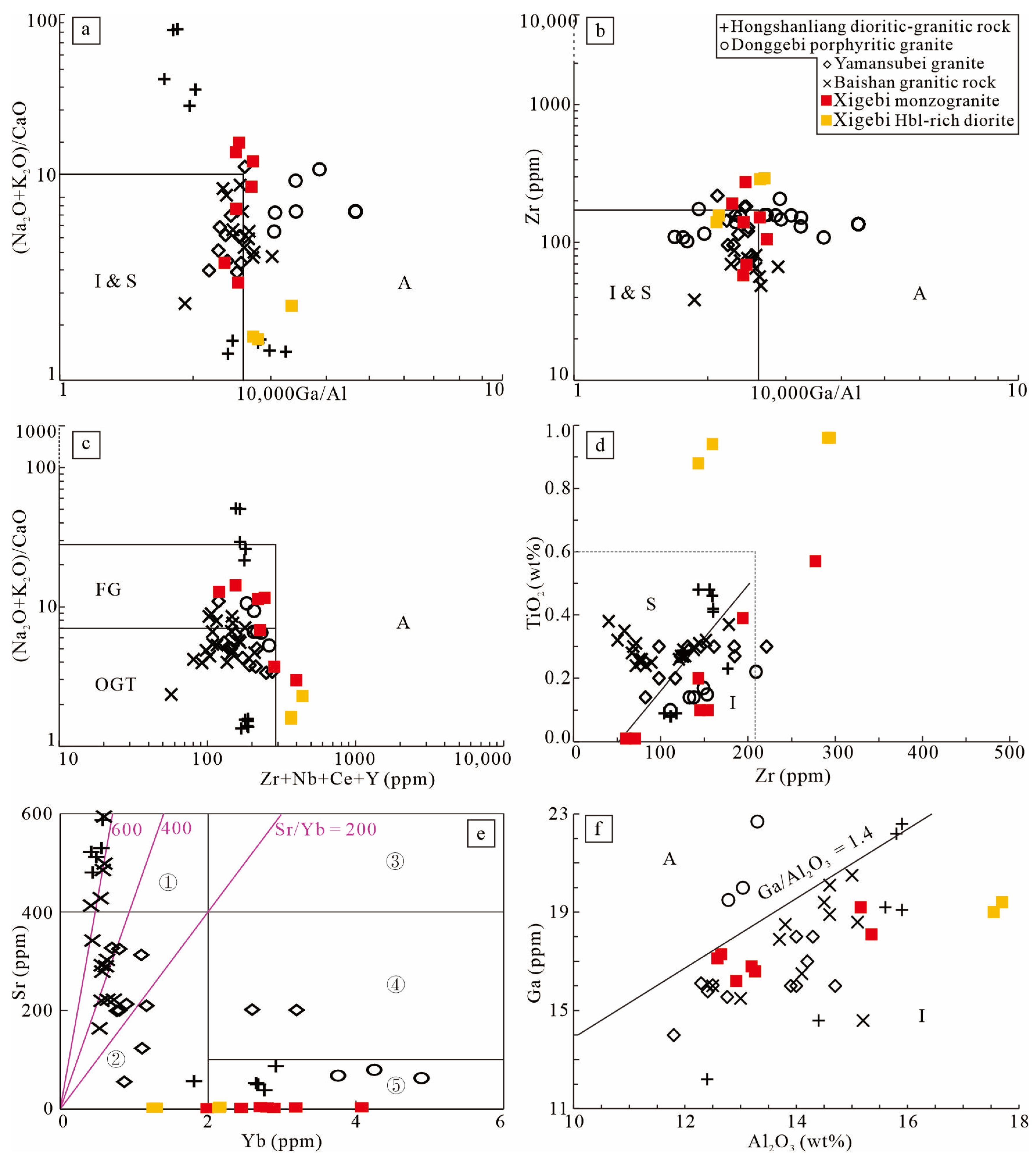
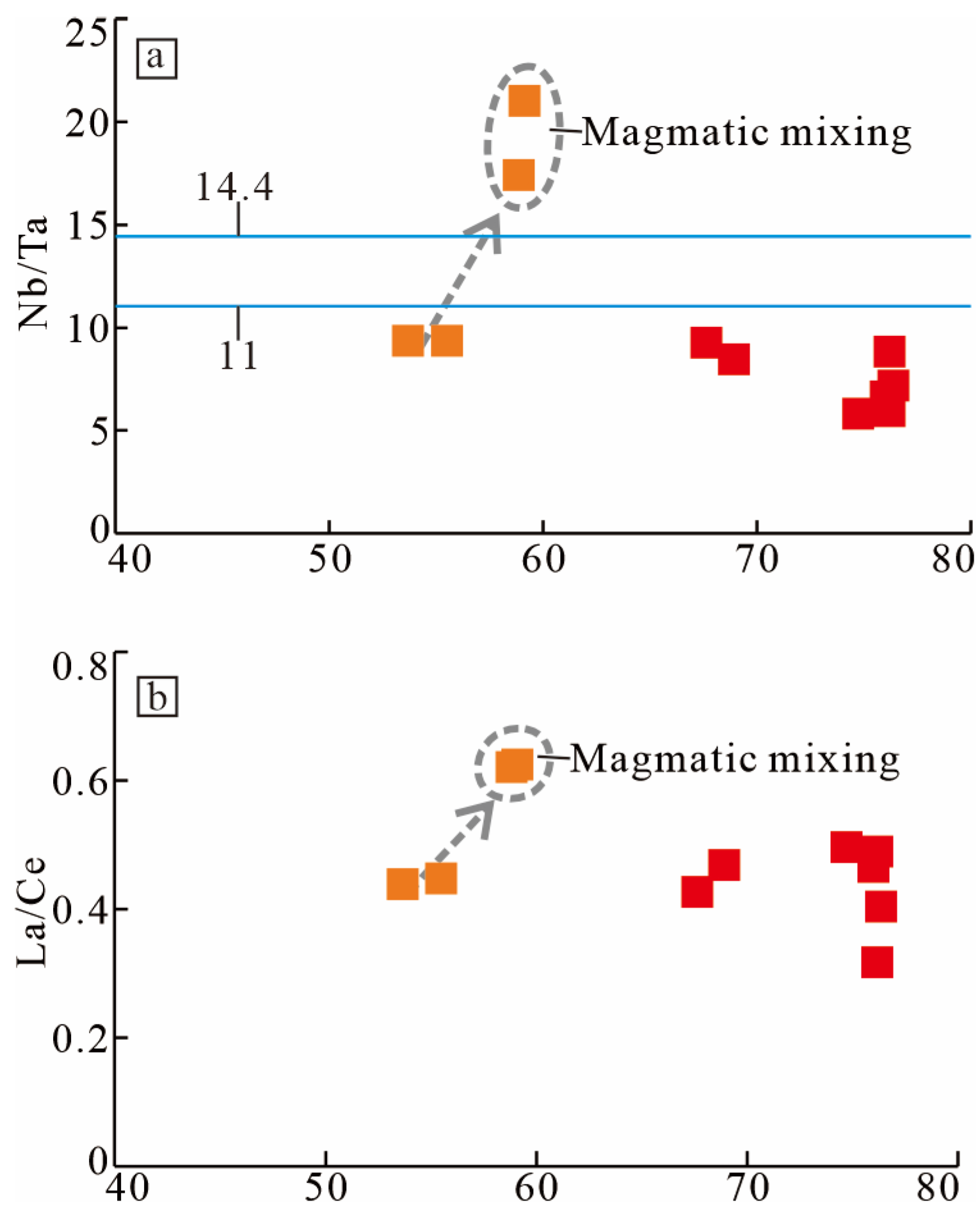

5.1.2. Monzogranite
5.2. Multiple-Stage Magmatism During Juvenile Crustal Reworking
5.3. Geological Implications
6. Conclusions
Supplementary Materials
Author Contributions
Funding
Data Availability Statement
Acknowledgments
Conflicts of Interest
References
- Li, W.Y. The primary discussion on the relationship between Paleo-Asian Ocean and Paleo-Tethys Ocean. Acta Petrol. Sin. 2018, 34, 2201–2210. [Google Scholar]
- Windley, B.F.; Alexeiev, D.; Xiao, W.J.; Kroener, A.; Badarch, G. Tectonic models for accretion of the Central Asian Orogenic Belt. J. Geol. Soc. 2007, 164, 31–47. [Google Scholar] [CrossRef]
- Xu, Z.Q.; Li, S.T.; Zhang, J.X.; Yang, J.S.; He, B.Z.; Li, H.B.; Lin, C.S.; Cai, Z.H. Paleo-Asian and Tethyan tectonic systems with docking the Tarim block. Acta Petrol. Sin. 2011, 27, 1–22. [Google Scholar]
- Dobretsov, N.L.; Buslov, M.M.; Vernikovsky, V.A. Neoproterozoic to Early Ordovician evolution of the Paleo-Asian Ocean: Implications to the break-up of Rodinia. Gondwana Res. 2003, 6, 143–159. [Google Scholar] [CrossRef]
- Zhao, G.C.; Cawood, P.A. Precambrian geology of China. Precambrian Res. 2012, 222, 13–54. [Google Scholar] [CrossRef]
- Li, Y.B.; Li, H.Q.; Zhou, W.X.; Wang, B.; Chang, F.; Li, S.C.; Yang, X.J. Neoproferozoic thermal events and tectonic implications inthe Beishan orogenic belt: Geochemical and geochronological evidence from two sets of granitic rocks from southern Beishanorogenic belt, Gansu Province. Geol. Bull. China 2021, 40, 1117–1139. [Google Scholar]
- Stern, R.J.; Li, S.M.; Keller, G.R. Continental crust of China: A brief guide for the perplexed. Earth-Sci. Rev. 2018, 179, 72–94. [Google Scholar] [CrossRef]
- Li, J.; Wu, C.; Chen, X.H.; Zuza, A.V.; Haproff, P.J.; Yin, A.; Shao, Z.G. Tectonic evolution of the Beishan orogen in central Asia: Subduction, accretion, and continent-continent collision during the closure of the Paleo-Asian Ocean. GSA Bull. 2022, 135, 819–851. [Google Scholar] [CrossRef]
- Xiao, W.J.; Mao, Q.G.; Windley, B.F.; Han, C.M.; Qu, J.F.; Zhang, J.E.; Ao, S.J.; Guo, Q.Q.; Cleven, N.R.; Lin, S.F.; et al. Paleozoic multiple accretionary and collisional processes of the Beishan orogenic collage. Am. J. Sci. 2010, 310, 1553–1594. [Google Scholar] [CrossRef]
- Xiao, W.J.; Zhang, L.C.; Qin, K.Z.; Sun, S.; Li, J.L. Paleozoic accretionary and collisional tectonics of the Eastern Tianshan (China): Implications for the continental growth of Central Asia. Am. J. Sci. 2004, 304, 370–395. [Google Scholar] [CrossRef]
- Chen, F.Y.; Wang, B.; Li, H.Q.; Chang, F. Zircon U-Pb geochronology, geochemistry and tectonic significance of the Peraluminous intrusive rocks in the Borenaobao-Bayanmende area, Xilinhot, Inner Mongolia. Miner. Explor. 2019, 10, 768–780. [Google Scholar]
- Deng, Y.F.; Yuan, F.; Hollings, P.; Song, X.Y.; Zhou, T.f.; Fu, B.; Denyszyn, S.; Zhao, B.b. Magma generation and sulfide saturation of Permian mafic-ultramafic intrusions from the western part of the Northern Tianshan in NW China: Implications for Ni-Cu mineralization. Miner. Depos. 2020, 55, 515–534. [Google Scholar] [CrossRef]
- Feng, W.Y.; Zhu, Y.F. Petrogenesis and tectonic implications of the late Carboniferous calc-alkaline and shoshonitic magmatic rocks in the Awulale mountain, western Tianshan. Gondwana Res. 2019, 76, 44–61. [Google Scholar] [CrossRef]
- Li, D.D.; Wang, Y.W.; Shi, Y.; Xie, H.J.; Wang, J.B.; Lai, C. Age and geochemistry of the Carboniferous-Permian magmatism and Fe-Ti-V oxide metallogeny in the Eastern Tianshan Orogen, NW China: Evidence from the Yaxi mafic-ultramafic complex. Int. Geol. Rev. 2019, 61, 853–867. [Google Scholar] [CrossRef]
- Su, B.X.; Qin, K.Z.; Sakyi, P.A.; Li, X.H.; Yang, Y.H.; Sun, H.; Tang, D.M.; Liu, P.P.; Xiao, Q.H.; Malaviarachchi, S.P.K. U-Pb ages and Hf-O isotopes of zircons from Late Paleozoic mafic-ultramafic units in the southern Central Asian Orogenic Belt: Tectonic implications and evidence for an Early-Permian mantle plume. Gondwana Res. 2011, 20, 516–531. [Google Scholar] [CrossRef]
- Zhao, L.D.; Chen, H.Y.; Hollings, P.; Han, J.S. Late Paleozoic magmatism and metallogenesis in the Agishan-Yamansu belt, Eastern Tianshan: Constraints from the Bailingshan intrusive complex. Gondwana Res. 2019, 65, 68–85. [Google Scholar] [CrossRef]
- Liu, H.F.; Zhao, H.; Guo, R.L.; Wang, G.C.; Liao, Q.A. Geochronology, geochemistry and geological implications of Early Carboniferous A-type granites in Harlik area from the Eastern Tianshan. Earth Sci. 2022, 47, 2245–2263. [Google Scholar]
- Zhou, W.X.; Zhao, X.C.; Lü, X.B. Petrology, Geochemistry and Chronology of the Baishahe Formation in Numohong Area of Eastern Kunlun Orogenic Belt. Earth Sci. 2020, 45, 4370–4388. [Google Scholar]
- Yang, H.; Xiao, W.; Mao, Q.; An, S.; Bai, Y.; Sang, M.; Cai, H.; Li, H. Two episodes of extension induced by slab rollback and root foundering in the Eastern Tianshan, southwestern Altaids: Insights from granites and intermediate dykes. Lithos 2024, 476-477, 107616. [Google Scholar] [CrossRef]
- Gao, F.; Cheng, Y.; Guo, R.; Liu, X.; Liu, Z. The Late Carboniferous Mafic–Ultramafic Complex Induced by Slab Breakoff in Eastern North Tianshan, Central Asian Orogenic Belt. Minerals 2023, 13, 1293. [Google Scholar] [CrossRef]
- Feng, W.Y.; Zheng, J.H. Triassic magmatism and tectonic setting of the eastern Tianshan, NW China: Constraints from the Weiya intrusive complex. Lithos 2021, 394, 106171. [Google Scholar] [CrossRef]
- Mao, Q.G.; Ao, S.J.; Windley, B.F.; Wang, J.B.; Li, Y.C.; Xiao, W.J. Middle Triassic lower crust-derived adakitic magmatism: Thickening of the Dananhu intra-oceanic arc and its implications for arc-arc amalgamation in the Eastern Tianshan (NW China). Geol. J. 2021, 56, 3137–3154. [Google Scholar] [CrossRef]
- Lei, R.X.; Wu, C.Z.; Zhang, Z.Z.; Gu, L.X.; Tang, J.H.; Li, G.R. Geochronology, geochemistry and tectonic significances of the Yamansubei pluton in eastern Tianshan, Northwest China. Acta Petrol. Sin. 2013, 29, 2653–2664. [Google Scholar]
- Zhang, X.R.; Zhao, G.C.; Sun, M.; Han, Y.G.; Liu, Q. Triassic magmatic reactivation in Eastern Tianshan, NW China: Evidence from geochemistry and zircon U-Pb-Hf isotopes of granites. J. Asian Earth Sci. 2017, 145, 446–459. [Google Scholar] [CrossRef]
- Wu, Y.S.; Zhou, K.F.; Li, N.; Chen, Y.J. Zircon U-Pb dating and Sr-Nd-Pb-Hf isotopes of the ore-associated porphyry at the giant Donggebi Mo deposit, Eastern Tianshan, NW China. Ore Geol. Rev. 2017, 81, 794–807. [Google Scholar] [CrossRef]
- Wang, Y.H.; Xue, C.J.; Liu, J.J.; Zhang, F.F. Geological, geochronological, geochemical, and Sr-Nd-O-Hf isotopic constraints on origins of intrusions associated with the Baishan porphyry Mo deposit in eastern Tianshan, NW China. Miner. Depos. 2016, 51, 953–969. [Google Scholar] [CrossRef]
- Zhang, D.Y.; Zhou, T.F.; Yuan, F.; Xiao, W.J.; White, N.C.; Deng, Y.F.; Lu, W.W.; Deng, G. Petrogenesis and mineralization potential of a granite porphyry intrusion beneath the Baishan Mo deposit, Eastern Tianshan, NW China. J. Asian Earth Sci. 2015, 113, 254–265. [Google Scholar] [CrossRef]
- Mao, Q.G.; Xiao, W.J.; Buckman, S.; Huang, P.; Ao, S.J.; Song, D.F.; Zhang, J.e.; Sang, M.; Tan, Z.; Wang, H.; et al. Deformational History of the Kanguer Subduction Complex in the Eastern Tianshan (NW China): Implications for Paleozoic-Triassic Multiple Accretionary Tectonics of the Southern Altaids. Tectonics 2022, 41, e2022TC007527. [Google Scholar] [CrossRef]
- Zhao, T.Y.; Xiao, W.J.; Mao, Q.G.; Yang, H.; Abuduxun, N.; Li, P. The Wulanmoren Accretionary Complex unravels Early Devonian to Late Triassic multiple-arc amalgamation in the Tianshan Orogen (NW China). Earth Space Sci. 2023, 10, e2022EA002310. [Google Scholar] [CrossRef]
- Li, N.; Yang, F.Q.; Zhang, Z.X.; Yang, C.D. Geochemistry and chronology of the biotite granite in the Xiaobaishitou W-(Mo) deposit, eastern Tianshan, China: Petrogenesis and tectonic implications. Ore Geol. Rev. 2019, 107, 999–1019. [Google Scholar] [CrossRef]
- Wang, G.C.; Zhang, M.; Feng, J.l.; Liao, Q.A.; Zhang, X.H.; Kang, L.; Guo, R.L.; Xuan, Z.Y.; Han, K.Y. New understandling of the tectonic framework and evolution during the Neoproterozoic-Palecaic era in the Eiast’Tianshan Mountims. J. Ceomech. 2019, 25, 798–819. [Google Scholar]
- Chen, C.; Lv, X.B.; Wu, C.M.; Jiang, X.; Mao, C. Origin and Geodynamic Implications of Concealed Granite in Shadong Tungsten Deposit, Xinjiang, China: Zircon U-Pb Chronology, Geochemistry, and Sr-Nd-Hf Isotope Constraint. J. Earth Sci. 2018, 29, 114–129. [Google Scholar] [CrossRef]
- Deng, X.H.; Chen, Y.J.; Santosh, M.; Wang, J.B.; Li, C.; Yue, S.W.; Zheng, Z.; Chen, H.J.; Tang, H.S.; Dong, L.H.; et al. U-Pb zircon, Re-Os molybdenite geochronology and Rb-Sr geochemistry from the Xiaobaishitou W (-Mo) deposit: Implications for Triassic tectonic setting in eastern Tianshan, NW China. Ore Geol. Rev. 2017, 80, 332–351. [Google Scholar] [CrossRef]
- Liu, S.Y.; Wang, R.; Jeon, H.; Hou, Z.Q.; Xue, Q.w.; Zhou, L.M.; Chen, S.B.; Zhang, Z.L.; Xi, B.B. Indosinian magmatism and rare metal mineralization in East Tianshan orogenic belt: An example study of Jingerquan Li-Be-Nb-Ta pegmatite deposit. Ore Geol. Rev. 2020, 116, 103265. [Google Scholar] [CrossRef]
- Sun, H.S.; Li, H.; Danisik, M.; Xia, Q.L.; Jiang, C.L.; Wu, P.; Yang, H.; Fan, Q.R.; Zhu, D.S. U-Pb and Re-Os geochronology and geochemistry of the Donggebi Mo deposit, Eastern Tianshan, NW China: Insights into mineralization and tectonic setting. Ore Geol. Rev. 2017, 86, 584–599. [Google Scholar] [CrossRef]
- Zhang, Z.Z.; Gu, L.X.; Wu, C.Z.; Li, W.Q.; Xi, A.H.; Shuo, W. Zircon SHRIMP dating for the Weiya pluton, Eastern Tianshan: Its geological implications. Acta Geol. Sin.-Engl. Ed. 2005, 79, 481–490. [Google Scholar]
- Wang, T.; Huang, H.; Zhang, J.; Wang, C.; Cao, G.; Xiao, W.; Yang, Q.; Bao, X. Voluminous continental growth of the Altaids and its control on metallogeny. Natl. Sci Rev 2022, 10, nwac283. [Google Scholar] [CrossRef]
- Zhang, Z.Z.; Gu, L.X.; Wu, C.Z.; Zhai, J.P.; Li, W.Q.; Tang, J.H. Early Indosinian Weiya Gabbro in Eastern Tianshan, China: Elemental and Sr-Nd-O isotopic geochemistry, and its tectonic implications. Acta Geol. Sin.-Engl. Ed. 2007, 81, 424–432. [Google Scholar]
- Zhang, Z.J.; Chen, H.Y.; Hu, M.Y.; Zhang, J.; Li, D.F. Isotopic geochemistry of the Jinwozi gold deposit in the eastern Tianshan orogen, NW China: Implications for the ore genesis. Geol. J. 2014, 49, 574–583. [Google Scholar] [CrossRef]
- Zhao, L.D.; Chen, H.Y.; Hollings, P.; Han, J.S. Tectonic transition in the Aqishan-Yamansu belt, Eastern Tianshan: Constraints from the geochronology and geochemistry of Carboniferous and Triassic igneous rocks. Lithos 2019, 344, 247–264. [Google Scholar] [CrossRef]
- Du, L.; Long, X.P.; Yuan, C.; Zhang, Y.Y.; Huang, Z.Y.; Wang, X.Y.; Yang, Y.H. Mantle contribution and tectonic transition in the Aqishan-Yamansu Belt, Eastern Tianshan, NW China: Insights from geochronology and geochemistry of Early Carboniferous to Early Permian felsic intrusions. Lithos 2018, 304, 230–244. [Google Scholar] [CrossRef]
- Mao, Q.G.; Xiao, W.J.; Fang, T.H.; Windley, B.F.; Sun, M.; Ao, S.J.; Zhang, J.E.; Huang, X.K. Geochronology, geochemistry and petrogenesis of Early Permian alkaline magmatism in the Eastern Tianshan: Implications for tectonics of the Southern Altaids. Lithos 2014, 190, 37–51. [Google Scholar] [CrossRef]
- Hu, Z.C.; Zhang, W.; Liu, Y.S.; Gao, S.; Li, M.; Zong, K.Q.; Chen, H.H.; Hu, S.H. “Wave” Signal-Smoothing and Mercury-Removing Device for Laser Ablation Quadrupole and Multiple Collector ICPMS Analysis: Application to Lead Isotope Analysis. Anal. Chem. 2015, 87, 1152–1157. [Google Scholar] [CrossRef]
- Liu, Y.S.; Gao, S.; Hu, Z.C.; Gao, C.G.; Zong, K.Q.; Wang, D.B. Continental and Oceanic Crust Recycling-induced Melt-Peridotite Interactions in the Trans-North China Orogen: U-Pb Dating, Hf Isotopes and Trace Elements in Zircons from Mantle Xenoliths. J. Petrol. 2010, 51, 537–571. [Google Scholar] [CrossRef]
- Liu, Y.S.; Hu, Z.C.; Gao, S.; Guenther, D.; Xu, J.; Gao, C.G.; Chen, H.H. In situ analysis of major and trace elements of anhydrous minerals by LA-ICP-MS without applying an internal standard. Chem. Geol. 2008, 257, 34–43. [Google Scholar] [CrossRef]
- Ludwig, K.R. ISOPLOT 3.00: A Geochronological Toolkit for Microsoft Excel; Berkeley Geochronology Center: Berkeley, CA, USA, 2003; Volume 4, p. 39. [Google Scholar]
- Hu, Z.C.; Liu, Y.S.; Gao, S.; Xiao, S.Q.; Zhao, L.S.; Guenther, D.; Li, M.; Zhang, W.; Zong, K.Q. A “wire” signal smoothing device for laser ablation inductively coupled plasma mass spectrometry analysis. Spectrochim. Acta Part B-At. Spectrosc. 2012, 78, 50–57. [Google Scholar] [CrossRef]
- Hu, Z.C.; Liu, Y.S.; Gao, S.; Liu, W.G.; Zhang, W.; Tong, X.R.; Lin, L.; Zong, K.Q.; Li, M.; Chen, H.H.; et al. Improved in situ Hf isotope ratio analysis of zircon using newly designed X skimmer cone and jet sample cone in combination with the addition of nitrogen by laser ablation multiple collector ICP-MS. J. Anal. At. Spectrom. 2012, 27, 1391–1399. [Google Scholar] [CrossRef]
- Woodhead, J.; Hergt, J.; Shelley, M.; Eggins, S.; Kemp, R. Zircon Hf-isotope analysis with an excimer laser, depth profiling, ablation of complex geometries, and concomitant age estimation. Chem. Geol. 2004, 209, 121–135. [Google Scholar] [CrossRef]
- Fisher, C.M.; Vervoort, J.D.; Hanchar, J.M. Guidelines for reporting zircon Hf isotopic data by LA-MC-ICPMS and potential pitfalls in the interpretation of these data. Chem. Geol. 2014, 363, 125–133. [Google Scholar] [CrossRef]
- Blichert-Toft, J.; Chauvel, C.; Albarede, F. Separation of Hf and Lu for high-precision isotope analysis of rock samples by magnetic sector multiple collector ICP-MS. Contrib. Mineral. Petrol. 1997, 127, 248–260. [Google Scholar] [CrossRef]
- Lu, Y.F. Geokit—A geochemical toolkit for Microsoft Excel. Geochimica 2004, 33, 459–464. [Google Scholar]
- Sun, S.S.; Mcdonough, W.E. Chemical and isotopic systematics of oceanic basalts: Implications for mantle composition and processes. Geol. Soc. Lond. Spec. Publ. 1989, 42, 313–345. [Google Scholar] [CrossRef]
- Loiselle, M.C. Characteristics and origin of anorogenic granites. Geol. Soc. America. Abstr. Programs 1979, 11, 468. [Google Scholar]
- Wright, J.B. A simple alkalinity ratio and its application to questions of non-orogenic granite genesis. Geol. Mag. 1969, 106, 370–384. [Google Scholar] [CrossRef]
- Peccerillo, A.; Taylor, S.R. Geochemistry of eocene calc-alkaline volcanic rocks from the Kastamonu area, Northern Turkey. Contrib. Mineral. Petrol. 1976, 58, 63–81. [Google Scholar] [CrossRef]
- Maniar, P.D.; Piccoli, P.M. Tectonic discrimination of granitoids. Geol. Soc. Am. Bull. 1989, 101, 635–643. [Google Scholar] [CrossRef]
- Frost, B.R.; Barnes, C.G.; Collins, W.J.; Arculus, R.J.; Ellis, D.J.; Frost, C.D. A geochemical classification for granitic rocks. J. Petrol. 2001, 42, 2033–2048. [Google Scholar] [CrossRef]
- Barbarin, B. A review of the relationships between granitoid types, their origins and their geodynamic environments. Lithos 1999, 46, 605–626. [Google Scholar] [CrossRef]
- Chappell, B.W.; White, A.J.R. I-Type and S-Type Granites in the Lachlan Fold Belt. Trans. R. Soc. Edinb.-Earth Sci. 1992, 83, 1–26. [Google Scholar]
- Zhang, Q.; Wang, Y.; Pan, G.Q.; Li, C.D.; Jin, W.J. Sources of granites: Some crucial questions on granite study (4). Acta Petrol. Sin. 2008, 24, 1193–1204. [Google Scholar]
- Bonin, B. A-type granites and related rocks: Evolution of a concept, problems and prospects. Lithos 2007, 97, 1–29. [Google Scholar] [CrossRef]
- Hanchar, J.M.; Watson, E.B. Zircon Saturation Thermometry. Rev. Mineral. Geochem. 2003, 53, 89–112. [Google Scholar] [CrossRef]
- Anderson, D.L. Chemical composition of the mantle. J. Geophys. Res. Solid Earth 1983, 88, B41–B52. [Google Scholar] [CrossRef]
- Hans Wedepohl, K. The composition of the continental crust. Geochim. Cosmochim. Acta 1995, 59, 1217–1232. [Google Scholar] [CrossRef]
- Whalen, J.B.; Currie, K.L.; Chappell, B.W. A-type granites: Geochemical characteristics, discrimination and petrogenesis. Contrib. Mineral. Petrol. 1987, 95, 407–419. [Google Scholar] [CrossRef]
- Chappell, B.W. Aluminum saturation in I-and S-type granites and the characterization of fractionated hapogranites. Lithos 1999, 46, 535–551. [Google Scholar] [CrossRef]
- Douce, A.E.P. Generation of metaluminous A-type granites by low-pressure melting of calc-alkaline granitoids. Geology 1997, 25, 743–746. [Google Scholar] [CrossRef]
- Skjerlie, K.P.; Dana, J.A. Fluid-Absent Melting Behavior of an F-Rich Tonalitic Gneiss at Mid-Crustal Pressures: Implications for the Generation of Anorogenic Granites. J. Petrol. 1993, 34, 785–815. [Google Scholar] [CrossRef]
- Clemens, J.D. Granitic magmas with I-type affinities, from mainly metasedimentary sources: The Harcourt batholith of southeastern Australia. Contrib. Mineral. Petrol. 2018, 173, 93. [Google Scholar] [CrossRef]
- Clemens, J.D.; Stevens, G.; Farina, F. The enigmatic sources of I-type granites: The peritectic connexion. Lithos 2011, 126, 174–181. [Google Scholar] [CrossRef]
- Sisson, T.W.; Ratajeski, K.; Hankins, W.B.; Glazner, A.F. Voluminous granitic magmas from common basaltic sources. Contrib. Mineral. Petrol. 2005, 148, 635–661. [Google Scholar] [CrossRef]
- Castro, A.; Morenoventas, I.; Delarosa, J.D. H-type (hybrid) granitoids: A proposed revision of the granite-type classification and nomenclature. Earth Sci. Rev. 1991, 31, 237–253. [Google Scholar] [CrossRef]
- Defant, M.J.; Drummond, M.S. Derivation of some modern arc magmas by melting of young subducted lithosphere. Nature 1990, 347, 662–665. [Google Scholar] [CrossRef]
- Cawthorn, R.G.; Strong, D.F.; Brown, P.A. Origin of corundum-normative intrusive and extrusive magmas. Nature 1976, 259, 102–104. [Google Scholar] [CrossRef]
- Chappell, B.W. Compositional variation within granite suites of the Lachlan fold belt: Its causes and implications for the physical state of granite magma. Trans. R. Soc. Edinb.-Earth Sci. 1996, 87, 159–170. [Google Scholar]
- Chappell, B.W.; White, A.J.R.; Wyborn, D. The importance of residual source material (restite) in granite petrogenesis. J. Petrol. 1987, 28, 1111–1138. [Google Scholar] [CrossRef]
- Bonin, B. Do coeval mafic and felsic magmas in post-collisional to within-plate regimes necessarily imply two contrasting, mantle and crustal, sources? A review. Lithos 2004, 78, 1–24. [Google Scholar] [CrossRef]
- Kocak, K.; Zedef, V.; Kansun, G. Magma mixing/mingling in the Eocene Horoz (Nigde) granitoids, Central southern Turkey: Evidence from mafic microgranular enclaves. Mineral. Petrol. 2011, 103, 149–167. [Google Scholar] [CrossRef]
- Wu, F.Y.; Li, X.H.; Zheng, Y.F.; Gao, S. Lu-Hf isotopic systematics and their applications in petrology. Acta Petrol. Sin. 2007, 23, 185–220. [Google Scholar]
- Taylor, S.R.; Mclennan, B. The Continental Crust: Its Composition and Evolution; Blackwell Scientific Publications: Oxford, UK, 1985; p. 312. [Google Scholar]
- Rapp, R.P.; Watson, E.B. Dehydration Melting of Metabasalt at 8–32 kbar: Implications for Continental Growth and Crust-Mantle Recycling. J. Petrol. 1995, 36, 891–931. [Google Scholar] [CrossRef]
- Jung, S.; Hoernes, S.; Mezger, K. Synorogenic melting of mafic lower crust: Constraints from geochronology, petrology and Sr, Nd, Pb and O isotope geochemistry of quartz diorites (Damara orogen, Namibia). Contrib. Mineral. Petrol. 2002, 143, 551–566. [Google Scholar] [CrossRef]
- Hibbard, M.J. Textural anatomy of twelve magma-mixed granitoid systems. Enclaves Granite Petrol. 1991, 13, 431–444. [Google Scholar]
- Holden, P.; Halliday, A.N.; Stephens, W.E. Neodymium and strontium isotope content of microdiorite enclaves points to mantle input to granitoid production. Nature 1987, 330, 53–56. [Google Scholar] [CrossRef]
- Vernon, R.H. Restite, xenoliths and microgranitoid enclaves in granites. J. Proc. R. Soc. N. S. W. 1983, 116, 77–103. [Google Scholar]
- Wang, D.Z.; Zhou, X.M.; Xu, X.S.; Yao, Y.P. On geneses of microgranitoid enclaves. J. Guilin Coll. Geol. 1992, 12, 235–241. [Google Scholar]
- Wang, D.Z.; Xie, L. Magma Mingling: Evidence from Enclaves. Geol. J. China Univ. 2008, 14, 16–21. [Google Scholar]
- Roberts, M.P.; Clemens, J.D. Origin of high-potassium, calc-alkaline, I-type granitoids. Geology 1993, 21, 825. [Google Scholar] [CrossRef]
- Zhang, Q.; Jin, W.J.; Li, C.D.; Wang, Y.L. Revisiting the new classification of granitic rocks based on whole-rock Sr and Yb contents: Index. Acta Petrol. Sin. 2010, 26, 985–1015. [Google Scholar]
- Zhang, Q.; Jin, W.J.; Li, C.D.; Wang, Y.L. On the classification of granitic rock based on whole-rock Sr and Yb concentrations III. Acta Petrol. Sin. 2010, 26, 3431–3455. [Google Scholar]
- Collins, W.J.; Beams, S.D.; White, A.J.R.; Chappell, B.W. Nature and origin of A-type granites with particular reference to southeastern Australia. Contrib. Mineral. Petrol. 1982, 80, 189–200. [Google Scholar] [CrossRef]
- Ballouard, C.; Massuyeau, M.; Elburg, M.A.; Tappe, S.; Viljoen, F.; Brandenburg, J.-T. The magmatic and magmatic-hydrothermal evolution of felsic igneous rocks as seen through Nb-Ta geochemical fractionation, with implications for the origins of rare-metal mineralizations. Earth-Sci. Rev. 2020, 203, 103115. [Google Scholar] [CrossRef]
- Ballouard, C.; Poujol, M.; Boulvais, P.; Branquet, Y.; Tartèse, R.; Vigneresse, J.-L. Nb-Ta fractionation in peraluminous granites: A marker of the magmatic-hydrothermal transition. Geology 2016, 44, 231–234. [Google Scholar] [CrossRef]
- Chen, X.J.; Shu, L.S.; Santosh, M.; Xu, Z.Q. The provenance and tectonic affinity of the Paleozoic meta-sedimentary rocks in the Chinese Tianshan belt: New insights from detrital zircon U-Pb geochronology and Hf-isotope analysis. J. Asian Earth Sci. 2014, 94, 12–27. [Google Scholar] [CrossRef]
- Bai, J.K.; Chen, J.L.; Tang, Z.; Zhang, Y. The closure time of Junggar Paleozoic oceanic basin:Evidence from Carboniferous de-trital zircon U-Pbgeochronology in Kalamaili area. Geol. Bull. China 2018, 37, 26–38. [Google Scholar]
- Li, Y.P.; Li, J.Y.; Sun, G.H.; Zhu, Z.X.; Yang, Z.Q. Basement of Junggar basin; evidence from detrital zircons insandstone of previous Devonian Kalamaili formation. Acta Petrol. Sin. 2007, 23, 1577–1590. [Google Scholar]
- Wu, B.; He, G.Q.; Wu, T.R.; Li, H.J.; Luo, H.L. Discovery of the Buergen ophiolitic melange belt in Xinjiang and its tectonic significance. Geol. China 2006, 33, 476–486. [Google Scholar]
- Dong, S.; Li, Z.; Jiang, L. The Ordovician-Silurian tectonic evolution of the northeastern margin of the Tarim block, NW China: Constraints from detrital zircon geochronological records. J. Asian Earth Sci. 2016, 122, 1–19. [Google Scholar] [CrossRef]
- Han, Y.G.; Zhao, G.C.; Sun, M.; Eizenhoefer, P.R.; Hou, W.Z.; Zhang, X.R.; Liu, D.X.; Wang, B.; Zhang, G.W. Paleozoic accretionary orogenesis in the Paleo-Asian Ocean: Insights from detrital zircons from Silurian to Carboniferous strata at the northwestern margin of the Tarim Craton. Tectonics 2015, 34, 334–351. [Google Scholar] [CrossRef]
- Zhao, H.; Liao, Q.A.; Xiao, D.; Luo, T.; Wang, L.Y.; Yin, T.W.; Liu, H.F. Discovery of the Early Silurian alkali basalt andits geological implications in northeastern Junggar, NW China. Acta Petrol. Sin. 2018, 34, 586–600. [Google Scholar]
- Ma, X.H.; Chen, B.; Wang, C.; Yan, X.L. Early Paleozoic subduction of the Paleo-Asian Ocean: Zircon UPbgeochronological, geochemical and Sr-Nd isotopic evidence from the Harlik pluton, Xinjiang. Acta Petrol. Sin. 2015, 31, 89–104. [Google Scholar]
- Li, J.T.; He, X.F.; Liu, L.; Yang, P.T.; Liang, B.; Su, H.; Yang, Y.D.; Han, H.M.; Liu, Y.Z.; Dai, Z.H. Ordovician Tectonic Evolution of Harlik in Eastern Tianshanof Xinjiang: Constraints from LA-ICP-MS Zircon U-PbGeochronology and Geochemistry of Volcanic Rocks. Geoscience 2017, 31, 460–473. [Google Scholar]
- Sun, Y.; Wang, J.B.; Li, Y.C.; Wang, Y.W.; Yu, M.J.; Long, L.L.; Lu, X.Q.; Chen, L. Recognition of Late Ordovician Yudai porphyry Cu (Au, Mo) mineralization in the Kalatag district, Eastern Tianshan terrane, NW China: Constraints from geology, geochronology, and petrology. Ore Geol. Rev. 2018, 100, 220–236. [Google Scholar] [CrossRef]
- Su, W.B.; Cai, K.D.; Sun, M.; Wan, B.; Wang, X.S.; Bao, Z.H.; Xiao, W.J. Carboniferous volcanic rocks associated with back-arc extension in the western Chinese Tianshan, NW China: Insight from temporal-spatial character, petrogenesis and tectonic significance. Lithos 2018, 310, 241–254. [Google Scholar] [CrossRef]
- Zha, Y.H.; Wang, G.C.; Shen, T.Y.; Cao, T.L.; Zhang, P. Geochronology and Deformation Stages of Koumenzi Ductile Shear Zone in Harlik Mountain, Xinjiang. Geotecton. Et Metallog. 2019, 44, 297–310. [Google Scholar]
- Wang, Y.F.; Chen, H.Y.; Falloone, J.T.; Han, J.S. The Paleozoic-Mesozoic magmatic evolution of the Eastern Tianshan, NW China: Constraints from geochronology and geochemistry of the Sanchakou intrusive complex. Gondwana Res. 2022, 103, 1–22. [Google Scholar] [CrossRef]
- Chen, W.; Sun, S.; Zhang, Y.; Xiao, W.J.; Wang, Y.T.; Wang, Q.L.; Jiang, L.F.; Yang, J.T. 40Ar/39Ar Gcochronology of the Qiugemingtashi-Huangshan Ductile Shear Zone in East Tianshan, Xinjiang, NW China. Acta Geol. Sin. 2005, 79, 790–804. [Google Scholar]
- He, Z.Y.; Wang, B.; Glorie, S.; Su, W.B.; Ni, X.H.; Jepson, G.; Liu, J.H.; Zhong, L.L.; Gillespie, J.; Grave, D.J. Mesozoic building of the Eastern Tianshan and East Junggar (NW China) revealed by low-temperature thermochronology. Gondwana Res. 2022, 103, 37–53. [Google Scholar] [CrossRef]
- Wang, B.; Shu, L.S.; Faure, M.; Jahn, B.; Cluzel, D.; Charvet, J.; Chung, S.l.; Meffre, S. Paleozoic tectonics of the southern Chinese Tianshan: Insights from structural, chronological and geochemical studies of the Heiyingshan ophiolitic melange (NW China). Tectonophysics 2011, 497, 85–104. [Google Scholar] [CrossRef]
- Wang, B.R.; Yang, X.S.; Li, S.C.; Teng, C.; Yang, X.J.; Huang, F.Y.; Zhang, X.F.; Cao, J.; Zhou, Y.; Zhang, H.C.; et al. Geochronology, geochemistry, and tectonic implications of early Neoproterozoic granitic rocks from the eastern Beishan Orogenic Belt, southern Central Asian Orogenic Belt. Precambrian Res. 2021, 352, 106016. [Google Scholar] [CrossRef]

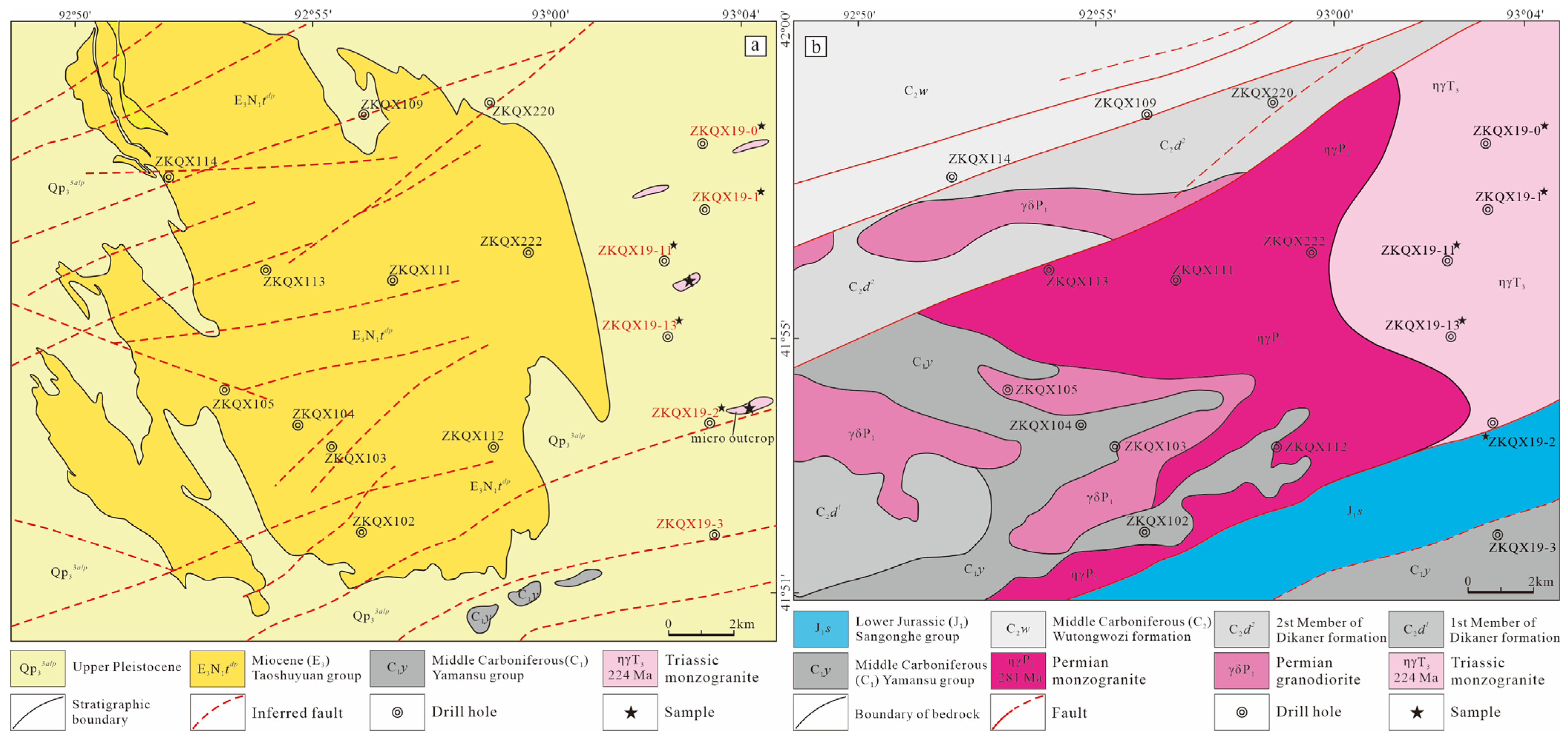

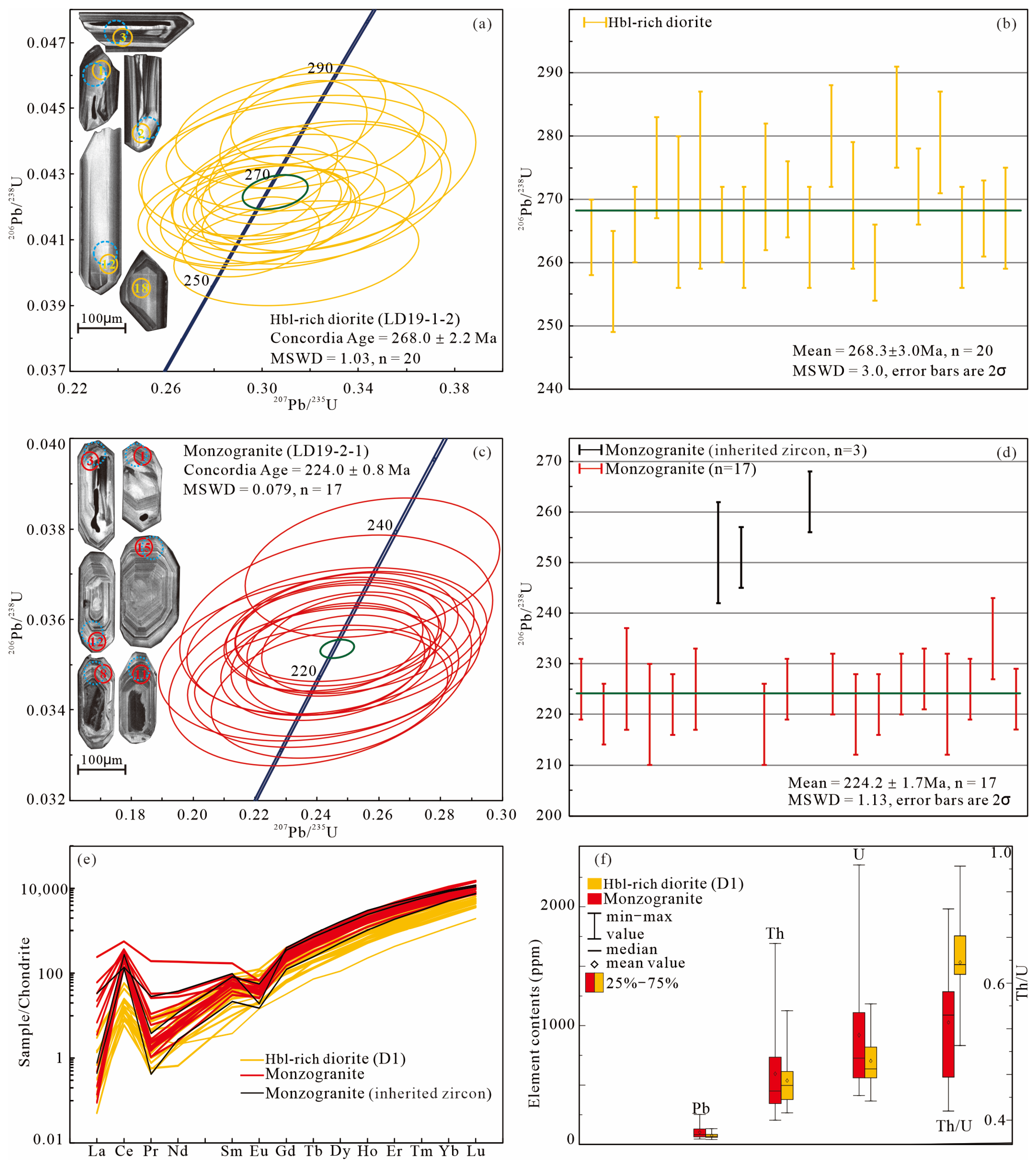
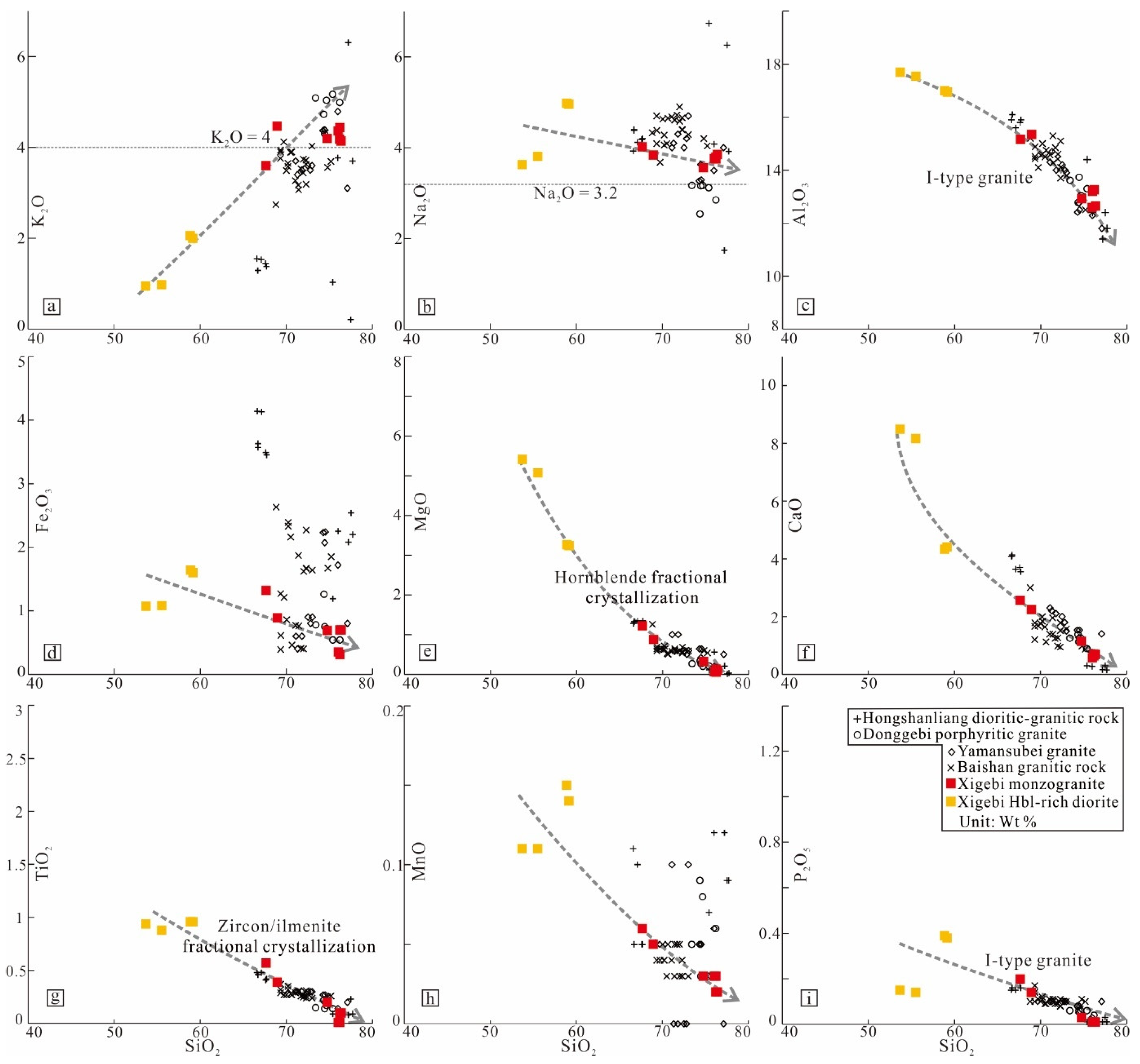
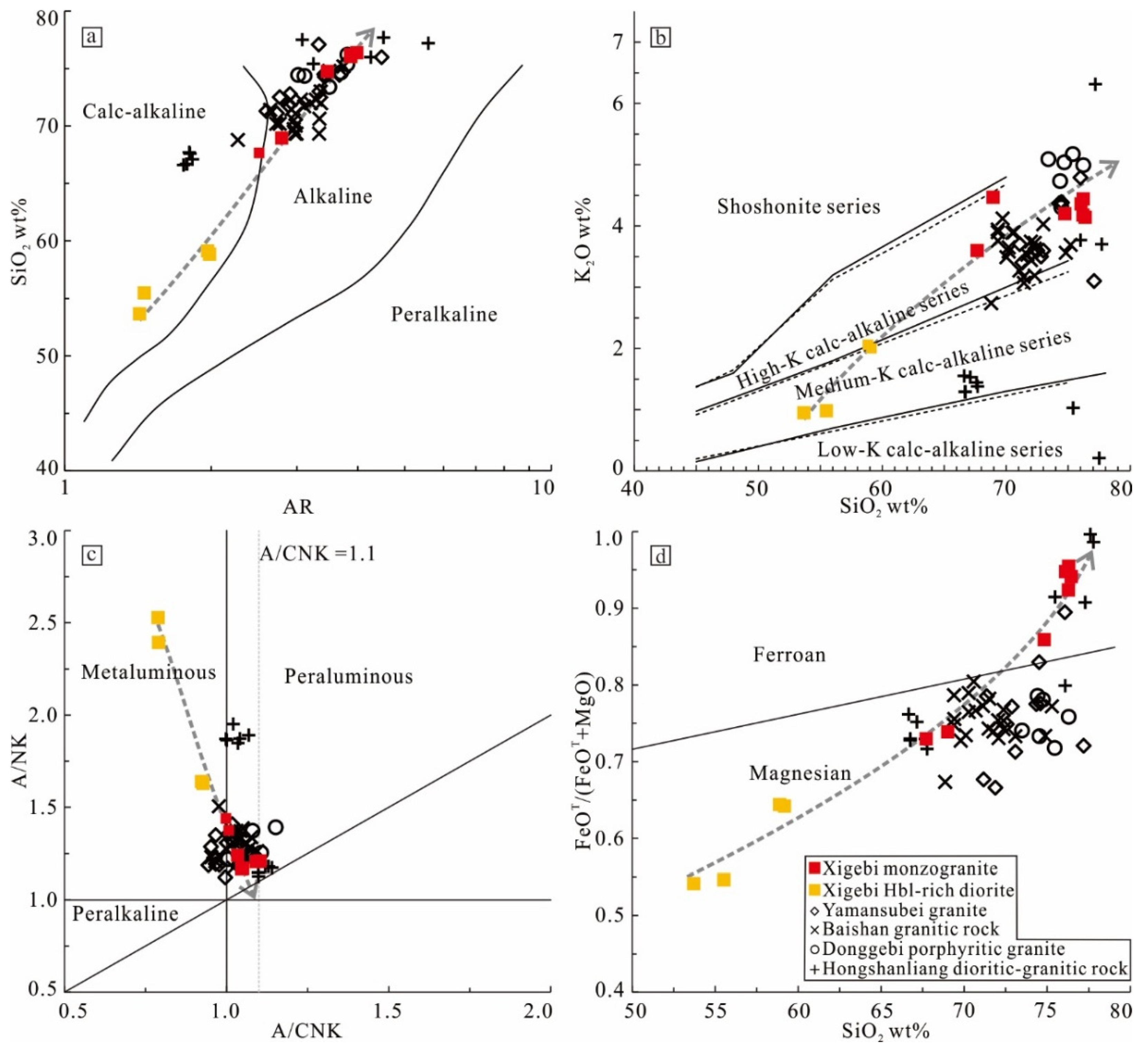
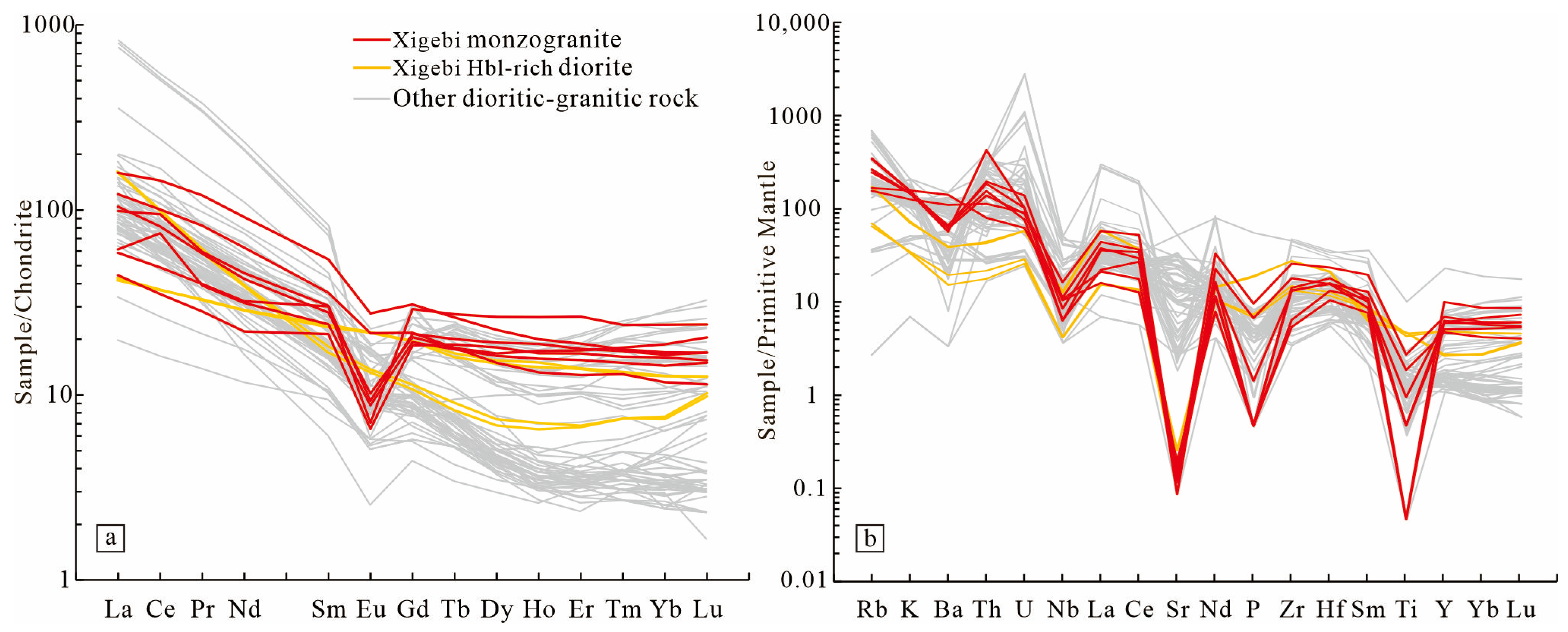



Disclaimer/Publisher’s Note: The statements, opinions and data contained in all publications are solely those of the individual author(s) and contributor(s) and not of MDPI and/or the editor(s). MDPI and/or the editor(s) disclaim responsibility for any injury to people or property resulting from any ideas, methods, instructions or products referred to in the content. |
© 2025 by the authors. Licensee MDPI, Basel, Switzerland. This article is an open access article distributed under the terms and conditions of the Creative Commons Attribution (CC BY) license (https://creativecommons.org/licenses/by/4.0/).
Share and Cite
Wei, M.; Li, H.; Zhou, W.; Muredili, M.; Fru, E.C.; Sheldrick, T. The Multiple Stages of Regional Triassic Crustal Reworking in Eastern Tianshan, NW China: Evidence from the Xigebi Area. Minerals 2025, 15, 829. https://doi.org/10.3390/min15080829
Wei M, Li H, Zhou W, Muredili M, Fru EC, Sheldrick T. The Multiple Stages of Regional Triassic Crustal Reworking in Eastern Tianshan, NW China: Evidence from the Xigebi Area. Minerals. 2025; 15(8):829. https://doi.org/10.3390/min15080829
Chicago/Turabian StyleWei, Ming, Haiquan Li, Wenxiao Zhou, Mahemuti Muredili, Ernest Chi Fru, and Thomas Sheldrick. 2025. "The Multiple Stages of Regional Triassic Crustal Reworking in Eastern Tianshan, NW China: Evidence from the Xigebi Area" Minerals 15, no. 8: 829. https://doi.org/10.3390/min15080829
APA StyleWei, M., Li, H., Zhou, W., Muredili, M., Fru, E. C., & Sheldrick, T. (2025). The Multiple Stages of Regional Triassic Crustal Reworking in Eastern Tianshan, NW China: Evidence from the Xigebi Area. Minerals, 15(8), 829. https://doi.org/10.3390/min15080829







